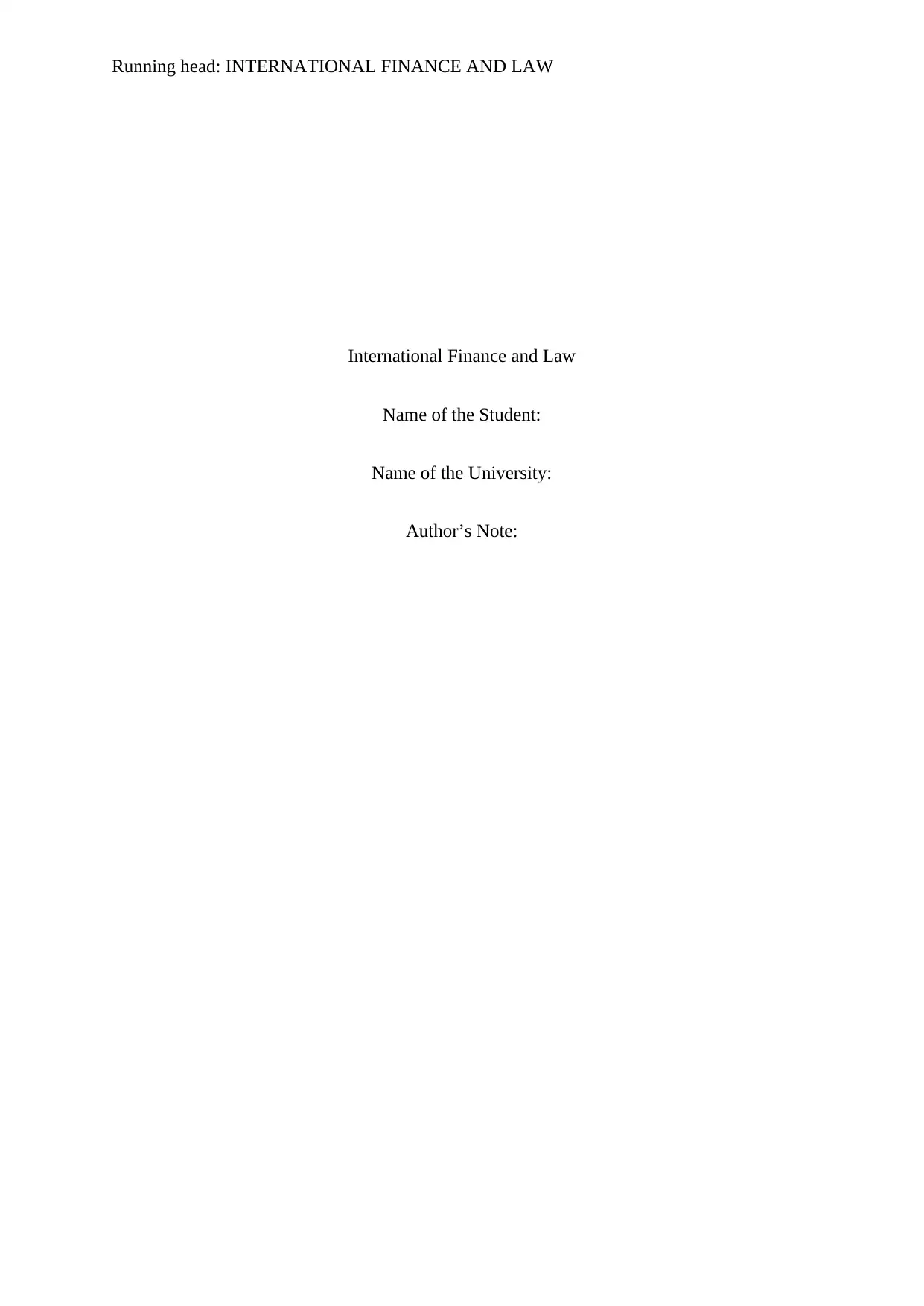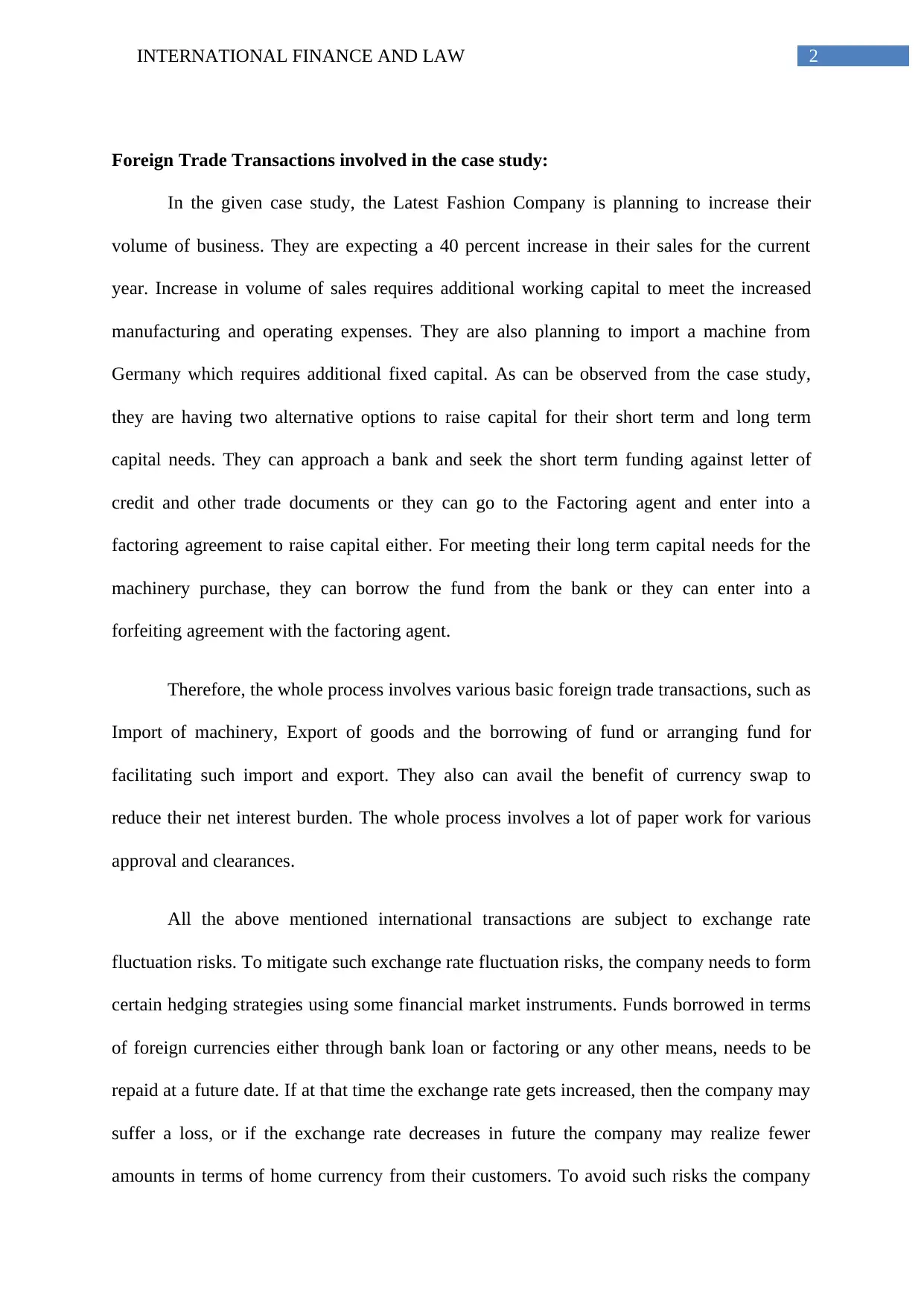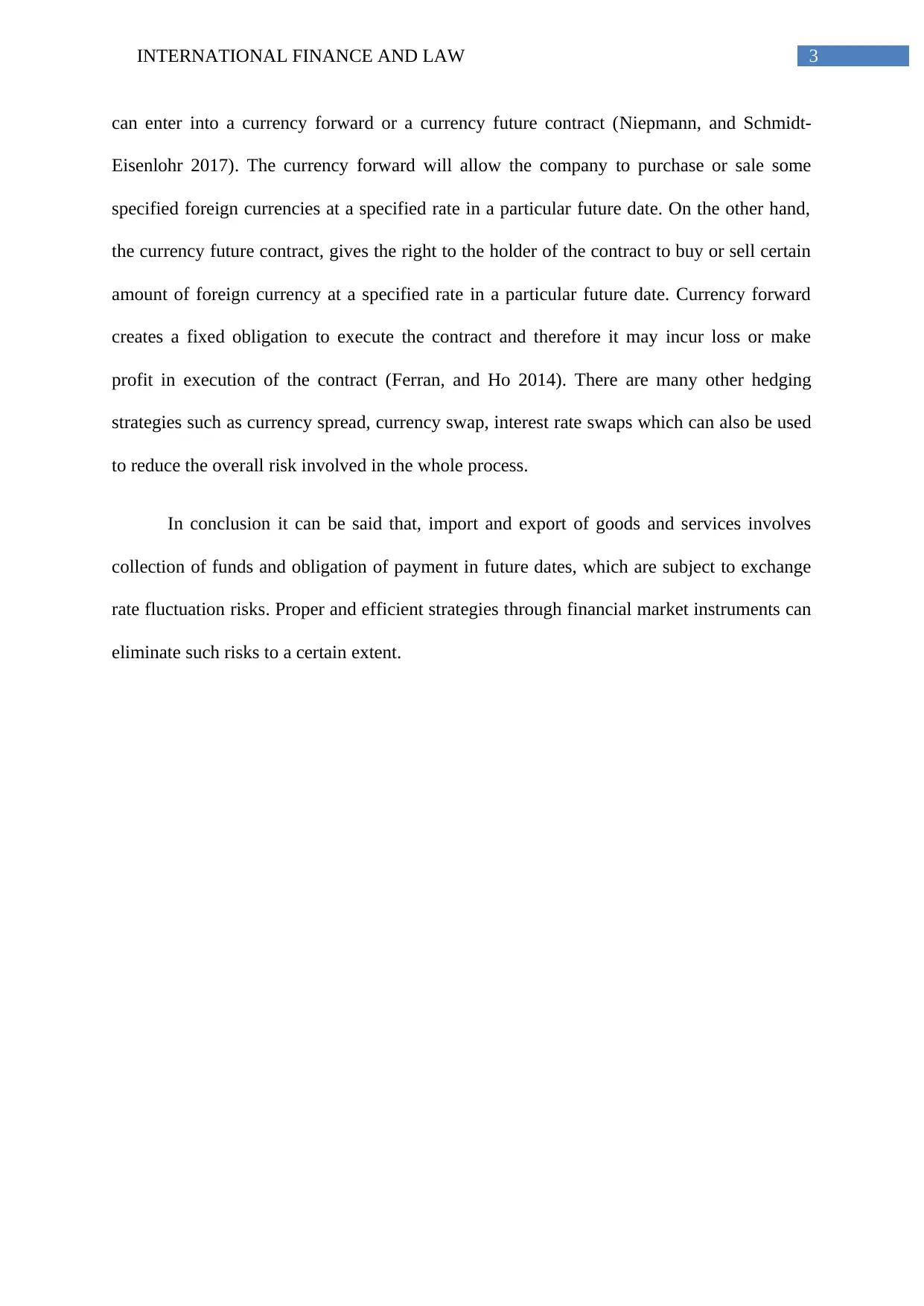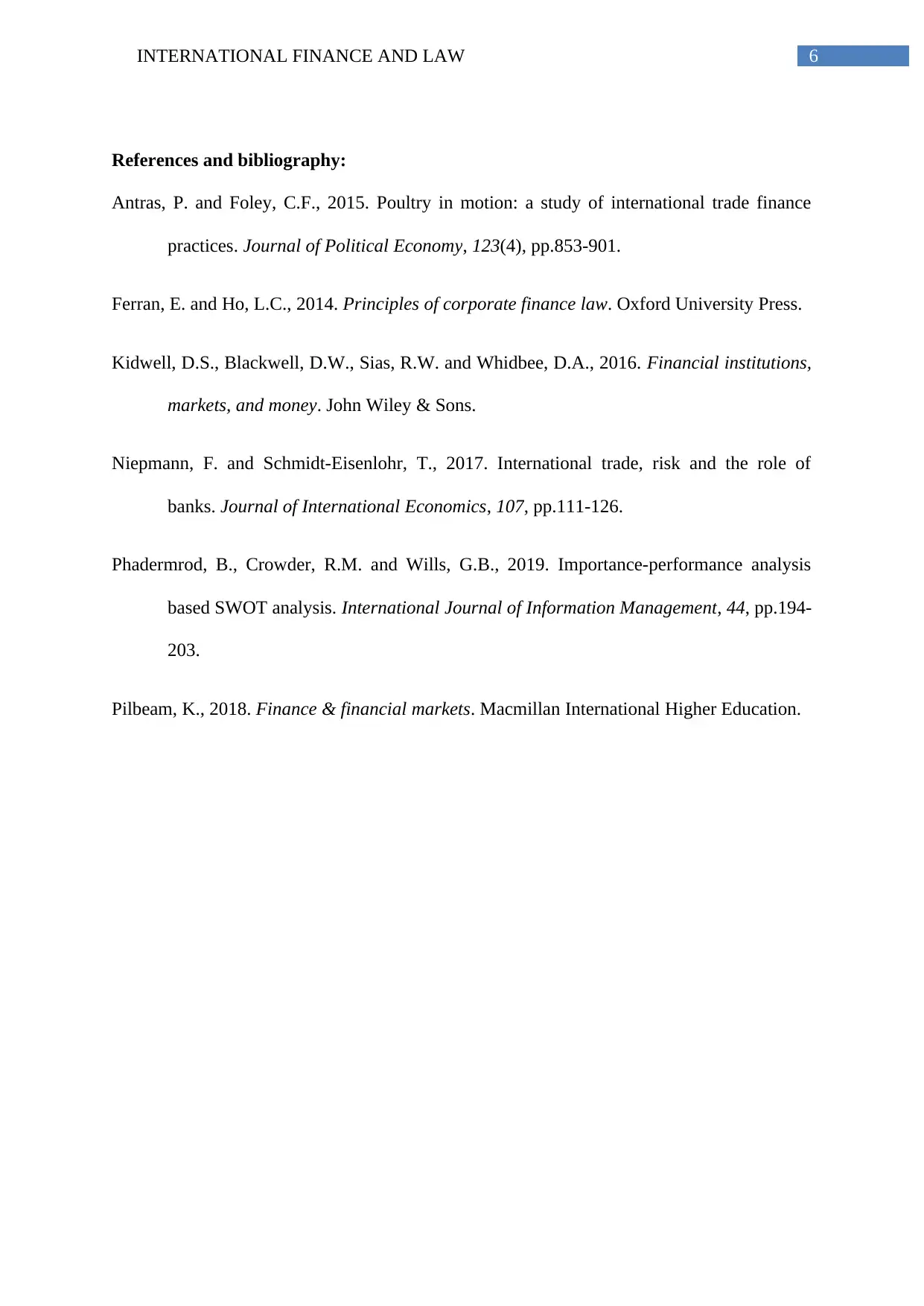University Finance Case Study: International Trade and Law
VerifiedAdded on 2023/01/16
|7
|1063
|83
Case Study
AI Summary
This case study examines the financial strategies of the Latest Fashion Company, an Indian textile manufacturer, as it plans to expand its business through international trade. The analysis covers foreign trade transactions, including import and export, and the need for short-term and long-term capital. It explores various financing options, such as bank loans, factoring, and forfeiting, along with the associated risks of exchange rate fluctuations. The study emphasizes the importance of hedging strategies like currency forwards, futures, and swaps to mitigate these risks. A SWOT analysis of the company highlights its strengths (solvency, high growth), weaknesses (lack of financial plans, insufficient capital), opportunities (international market expansion), and threats (exchange rate risks, political barriers). The document concludes with references and a bibliography, offering a comprehensive overview of international finance and its practical application in a business context.

Running head: INTERNATIONAL FINANCE AND LAW
International Finance and Law
Name of the Student:
Name of the University:
Author’s Note:
International Finance and Law
Name of the Student:
Name of the University:
Author’s Note:
Paraphrase This Document
Need a fresh take? Get an instant paraphrase of this document with our AI Paraphraser

1INTERNATIONAL FINANCE AND LAW
Table of Contents
Foreign Trade Transactions involved in the case study:............................................................2
SWOT analysis of the company:................................................................................................4
References and bibliography:.....................................................................................................5
Table of Contents
Foreign Trade Transactions involved in the case study:............................................................2
SWOT analysis of the company:................................................................................................4
References and bibliography:.....................................................................................................5

2INTERNATIONAL FINANCE AND LAW
Foreign Trade Transactions involved in the case study:
In the given case study, the Latest Fashion Company is planning to increase their
volume of business. They are expecting a 40 percent increase in their sales for the current
year. Increase in volume of sales requires additional working capital to meet the increased
manufacturing and operating expenses. They are also planning to import a machine from
Germany which requires additional fixed capital. As can be observed from the case study,
they are having two alternative options to raise capital for their short term and long term
capital needs. They can approach a bank and seek the short term funding against letter of
credit and other trade documents or they can go to the Factoring agent and enter into a
factoring agreement to raise capital either. For meeting their long term capital needs for the
machinery purchase, they can borrow the fund from the bank or they can enter into a
forfeiting agreement with the factoring agent.
Therefore, the whole process involves various basic foreign trade transactions, such as
Import of machinery, Export of goods and the borrowing of fund or arranging fund for
facilitating such import and export. They also can avail the benefit of currency swap to
reduce their net interest burden. The whole process involves a lot of paper work for various
approval and clearances.
All the above mentioned international transactions are subject to exchange rate
fluctuation risks. To mitigate such exchange rate fluctuation risks, the company needs to form
certain hedging strategies using some financial market instruments. Funds borrowed in terms
of foreign currencies either through bank loan or factoring or any other means, needs to be
repaid at a future date. If at that time the exchange rate gets increased, then the company may
suffer a loss, or if the exchange rate decreases in future the company may realize fewer
amounts in terms of home currency from their customers. To avoid such risks the company
Foreign Trade Transactions involved in the case study:
In the given case study, the Latest Fashion Company is planning to increase their
volume of business. They are expecting a 40 percent increase in their sales for the current
year. Increase in volume of sales requires additional working capital to meet the increased
manufacturing and operating expenses. They are also planning to import a machine from
Germany which requires additional fixed capital. As can be observed from the case study,
they are having two alternative options to raise capital for their short term and long term
capital needs. They can approach a bank and seek the short term funding against letter of
credit and other trade documents or they can go to the Factoring agent and enter into a
factoring agreement to raise capital either. For meeting their long term capital needs for the
machinery purchase, they can borrow the fund from the bank or they can enter into a
forfeiting agreement with the factoring agent.
Therefore, the whole process involves various basic foreign trade transactions, such as
Import of machinery, Export of goods and the borrowing of fund or arranging fund for
facilitating such import and export. They also can avail the benefit of currency swap to
reduce their net interest burden. The whole process involves a lot of paper work for various
approval and clearances.
All the above mentioned international transactions are subject to exchange rate
fluctuation risks. To mitigate such exchange rate fluctuation risks, the company needs to form
certain hedging strategies using some financial market instruments. Funds borrowed in terms
of foreign currencies either through bank loan or factoring or any other means, needs to be
repaid at a future date. If at that time the exchange rate gets increased, then the company may
suffer a loss, or if the exchange rate decreases in future the company may realize fewer
amounts in terms of home currency from their customers. To avoid such risks the company
⊘ This is a preview!⊘
Do you want full access?
Subscribe today to unlock all pages.

Trusted by 1+ million students worldwide

3INTERNATIONAL FINANCE AND LAW
can enter into a currency forward or a currency future contract (Niepmann, and Schmidt-
Eisenlohr 2017). The currency forward will allow the company to purchase or sale some
specified foreign currencies at a specified rate in a particular future date. On the other hand,
the currency future contract, gives the right to the holder of the contract to buy or sell certain
amount of foreign currency at a specified rate in a particular future date. Currency forward
creates a fixed obligation to execute the contract and therefore it may incur loss or make
profit in execution of the contract (Ferran, and Ho 2014). There are many other hedging
strategies such as currency spread, currency swap, interest rate swaps which can also be used
to reduce the overall risk involved in the whole process.
In conclusion it can be said that, import and export of goods and services involves
collection of funds and obligation of payment in future dates, which are subject to exchange
rate fluctuation risks. Proper and efficient strategies through financial market instruments can
eliminate such risks to a certain extent.
can enter into a currency forward or a currency future contract (Niepmann, and Schmidt-
Eisenlohr 2017). The currency forward will allow the company to purchase or sale some
specified foreign currencies at a specified rate in a particular future date. On the other hand,
the currency future contract, gives the right to the holder of the contract to buy or sell certain
amount of foreign currency at a specified rate in a particular future date. Currency forward
creates a fixed obligation to execute the contract and therefore it may incur loss or make
profit in execution of the contract (Ferran, and Ho 2014). There are many other hedging
strategies such as currency spread, currency swap, interest rate swaps which can also be used
to reduce the overall risk involved in the whole process.
In conclusion it can be said that, import and export of goods and services involves
collection of funds and obligation of payment in future dates, which are subject to exchange
rate fluctuation risks. Proper and efficient strategies through financial market instruments can
eliminate such risks to a certain extent.
Paraphrase This Document
Need a fresh take? Get an instant paraphrase of this document with our AI Paraphraser

4INTERNATIONAL FINANCE AND LAW
SWOT analysis of the company:
The Latest Fashion Pvt. Ltd is a textile manufacturer operating from the India, which
is the second largest country for textile industry. They have been performing well since last
couple of years financially and operationally. The company was able to meet their capital
requirements through their own sources, which is a sign for their high solvency. They are
having a sales growth rate of 30 percent and they are expecting a much higher growth rate in
future. Their strengths, weaknesses, potential opportunities and expected threats can be
tabulated in the following four quadrants.
Strengths:
The company is having a high degree
of solvency and liquidity.
The company is having a high growth
rate in demand for their products.
The company is operating
internationally and most of the
revenues come from the exports.
Weaknesses:
Lack of proper financial and
operational plans.
Lack of adequate amount of capital to
fund the growing demand for their
products
Lack of efficient hedging strategies.
Opportunities:
Large international market can be
captured if they can efficiently fund
the whole process.
Enter into emerging and developing
international market the Middle East
and Asian countries.
Development of Indian Textile
Threats:
High dependency on exports may
increase counter party risks.
All the international transactions
involve exchange rate fluctuation
risks.
Political barriers in entering into
various foreign countries.
SWOT analysis of the company:
The Latest Fashion Pvt. Ltd is a textile manufacturer operating from the India, which
is the second largest country for textile industry. They have been performing well since last
couple of years financially and operationally. The company was able to meet their capital
requirements through their own sources, which is a sign for their high solvency. They are
having a sales growth rate of 30 percent and they are expecting a much higher growth rate in
future. Their strengths, weaknesses, potential opportunities and expected threats can be
tabulated in the following four quadrants.
Strengths:
The company is having a high degree
of solvency and liquidity.
The company is having a high growth
rate in demand for their products.
The company is operating
internationally and most of the
revenues come from the exports.
Weaknesses:
Lack of proper financial and
operational plans.
Lack of adequate amount of capital to
fund the growing demand for their
products
Lack of efficient hedging strategies.
Opportunities:
Large international market can be
captured if they can efficiently fund
the whole process.
Enter into emerging and developing
international market the Middle East
and Asian countries.
Development of Indian Textile
Threats:
High dependency on exports may
increase counter party risks.
All the international transactions
involve exchange rate fluctuation
risks.
Political barriers in entering into
various foreign countries.

5INTERNATIONAL FINANCE AND LAW
Industry
Industry
⊘ This is a preview!⊘
Do you want full access?
Subscribe today to unlock all pages.

Trusted by 1+ million students worldwide

6INTERNATIONAL FINANCE AND LAW
References and bibliography:
Antras, P. and Foley, C.F., 2015. Poultry in motion: a study of international trade finance
practices. Journal of Political Economy, 123(4), pp.853-901.
Ferran, E. and Ho, L.C., 2014. Principles of corporate finance law. Oxford University Press.
Kidwell, D.S., Blackwell, D.W., Sias, R.W. and Whidbee, D.A., 2016. Financial institutions,
markets, and money. John Wiley & Sons.
Niepmann, F. and Schmidt-Eisenlohr, T., 2017. International trade, risk and the role of
banks. Journal of International Economics, 107, pp.111-126.
Phadermrod, B., Crowder, R.M. and Wills, G.B., 2019. Importance-performance analysis
based SWOT analysis. International Journal of Information Management, 44, pp.194-
203.
Pilbeam, K., 2018. Finance & financial markets. Macmillan International Higher Education.
References and bibliography:
Antras, P. and Foley, C.F., 2015. Poultry in motion: a study of international trade finance
practices. Journal of Political Economy, 123(4), pp.853-901.
Ferran, E. and Ho, L.C., 2014. Principles of corporate finance law. Oxford University Press.
Kidwell, D.S., Blackwell, D.W., Sias, R.W. and Whidbee, D.A., 2016. Financial institutions,
markets, and money. John Wiley & Sons.
Niepmann, F. and Schmidt-Eisenlohr, T., 2017. International trade, risk and the role of
banks. Journal of International Economics, 107, pp.111-126.
Phadermrod, B., Crowder, R.M. and Wills, G.B., 2019. Importance-performance analysis
based SWOT analysis. International Journal of Information Management, 44, pp.194-
203.
Pilbeam, K., 2018. Finance & financial markets. Macmillan International Higher Education.
1 out of 7
Related Documents
Your All-in-One AI-Powered Toolkit for Academic Success.
+13062052269
info@desklib.com
Available 24*7 on WhatsApp / Email
![[object Object]](/_next/static/media/star-bottom.7253800d.svg)
Unlock your academic potential
Copyright © 2020–2025 A2Z Services. All Rights Reserved. Developed and managed by ZUCOL.





